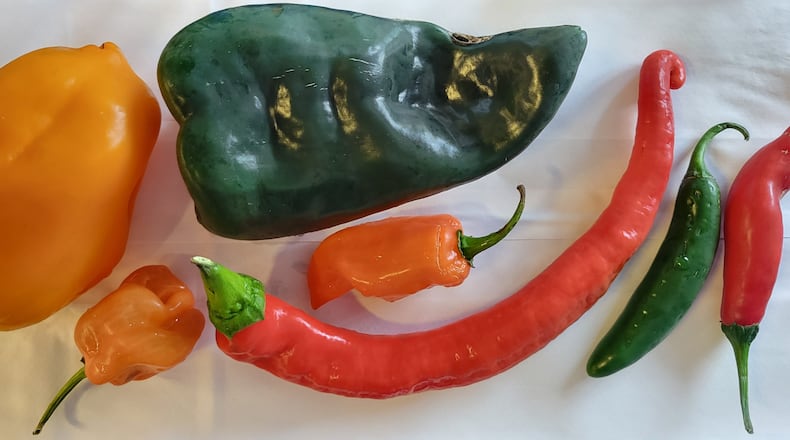A pepper’s heat level is measured according to the Scoville Heat Unit (SHU). The measuring system was invented in 1912 by a pharmacist named Wilbur Scoville. He prepared and repeatedly diluted a sample of chili with sugar-water until five test subjects no longer felt any heat. Not a job I would want.
The score on the scale represents the level of dilution required for the sensation of heat to disappear completely. Since the 1980s, high-tech machines have largely replaced human tasters, but the results are still converted back to Scoville Heat Units.
Each pepper receives a range of SHU. Two samples of a specific type of pepper can have different SHUs if they were grown at different locations in different soils.
Scoville may have had a local connection. He married Cora Upham, and Miami’s President between 1928 and 1945 was Alfred Upham. But they probably weren’t related.
I researched the SHU for four of the numerous types of “hot” peppers grown at Craig and Sharon Harkrider’s Stoney Hedgerow Farm and recently available at MOON Co-op and the Oxford Farmers Market. I describe them in order from low SHU (i.e. “mild”) to high SHU (“incendiary”).
- Poblano (SHU 1,000-2,000) is among the mildest of the so-called hot peppers. It has a dark green color and a chunky shape suitable for stuffing. Poblano is often used in Mexican dishes like mole.
- Serrano (SHU 10,000-25,000) is considered medium hot. It is maybe 3 inches long and thin, either red or green. Serranos are often used in salsa and in Thai cuisine.
- Cayenne (SHU 30,000-40,000) is a well-known hot pepper, because it is often dried and sold as powder or flakes in spice jars. Cayenne powder is available at MOON Co-op in the bulk section, so one can buy a small quantity.
- Habanero (SHU 100,000-350,000) is a shriveled orange-colored highly incendiary pepper. It is recommended that you wear gloves when preparing habaneros, and remove the seeds and veins to cut down a bit on the heat.
When I was a student in London, friends invited me over for “American-style” chili. The hot peppers they used produced chili that was way too hot to eat.
Capsaicin is oily and thus repels water, so water doesn’t reduce the burning from eating a hot pepper. If a dish is too incendiary to eat, best bet for calming it is adding yogurt, cheese, or beer. Capsaicin is soluble in dairy products and alcohol. Or do like my friends in London, give up, and find something else to eat in the fridge.
Local hot peppers can be found at MOON Co-op Natural Foods Market and Deli, Oxford’s consumer-owned full-service grocery, featuring natural, local, organic, sustainable, and Earth-friendly products. The store, located at 516 S. Locust St. in Oxford, is open to the public every day. See it online at mooncoop.coop.
About the Author
